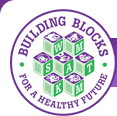
| Brought to you by the US Department of Health and Human Services, Substance Abuse & Mental health Services Administration |
 |
Home  About Us About Us  Links Links  Get E-mail Updates Get E-mail Updates  Awards Awards |
 |
|||
|
|
|||||
| Send this page to a friend | Print this page |  |
||||
|
|
 |
 
Obesity and Making Healthy Food ChoicesSince the 1970s, the number of overweight and obese children of all ages has sharply increased. For children ages 2–5, the increase in both has more than doubled in the past 20 years. It is important to note that nearly one out of three children is overweight or obese in the United States. Serious short-term and long-term consequences result from obesity, including the increased risk for disorders such as hypertension, high cholesterol, type 2 diabetes, and sleep apnea. Why Are Our Children Obese?Several changes in the way we live contribute to childhood obesity. Children’s physical activity has markedly decreased, and their more sedentary activities, such as watching TV and playing video and computer games, have increased. We also eat food prepared away from home much more often, and many restaurants serve increasingly larger portions of food (See Building Blocks’ “Portion Distortion”). As caregivers and educators, you can help children and their families develop healthy eating habits. Purpose: Materials:
Preparation: Procedure: 2. Distribute the construction paper, glue/paste, markers and/or crayons, and one or two magazines to small groups of students. Have students cut out pictures of foods they heard in the song or that they think would be a good snack. Ask them to glue or paste these pictures onto the construction paper. Work with the groups to label their cutout pictures. Have the groups present their construction paper posters and discuss why each food pictured is a healthy snack. 4. Give each child a copy of the Healthy Snacks page from the Activity Book to take home to complete as a family activity. Have them bring back their completed activities to create a class list of favorite snacks or a class book of recipes. Going Further Resources:
|
|||||
| Site Map | Contact Us | FAQ | Ask SAMHSA | Privacy Policy | Web Site Policies | FOIA | USA.gov | Plain Language |
|
Updated on 3/21/2012 |